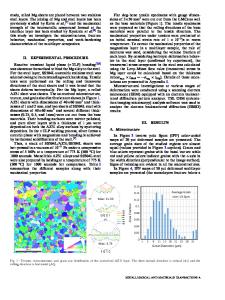Microstructure, Properties and Weldability of Duplex Stainless Steel 2101
- PDF / 2,020,538 Bytes
- 8 Pages / 593.972 x 792 pts Page_size
- 54 Downloads / 374 Views
JMEPEG DOI: 10.1007/s11665-016-2428-2
Microstructure, Properties and Weldability of Duplex Stainless Steel 2101 Li Ma, Shengsun Hu, and Junqi Shen (Submitted March 8, 2016; in revised form November 1, 2016) The continuous development of duplex stainless steels (DSSs) is due to their excellent corrosion resistance in aggressive environments and their mechanical strength, which is usually twice of conventional austenitic stainless steels (ASSs). In this paper, a designed lean duplex stainless steel 2101, with the alloy design of reduced nickel content and increased additions of manganese and nitrogen, is studied by being partly compared with typical ASS 304L steels. The microstructure, mechanical properties, impact toughness, corrosion resistance and weldability of the designed DSS 2101 were conducted. The results demonstrated that both 2101 steel and its weldment show excellent mechanical properties, impact toughness and corrosion resistance, so DSS 2101 exhibits good comprehensive properties and can be used to replace 304L in numerous applications. Keywords
corrosion resistance, duplex stainless steel, mechanical properties, microstructure, weldability
1. Introduction In the last few decades, duplex (austenitic-ferritic) stainless steel (DSS) grades were increasingly applied in the fossil fuel industry to replace austenitic or super austenitic grades for technical and/or economical reasons (Ref 1). Duplex grades containing high chromium (Cr), high nitrogen (N) and low nickel (Ni) contents exhibit attractive properties with excellent combination of mechanical properties (double yield strength of austenitic grades) and corrosion resistance (i.e., uniform, pitting and crevice corrosion, stress corrosion cracking and corrosion fatigue) (Ref 2), which is related to the relatively high N content (0.20-0.25 wt.%) and the dual-phase microstructure (50% ferrite and 50% austenite) (Ref 3). In the group of DSS, 2205 steel [EN 1.4462 (Ref 4), UNS S31803 (Ref 5)] with the composition system of Fe-22Cr-5Ni-3Mo-0.16N (in wt.%) is extensively recommended in many applications, such as oil and gas, flue-gas cleaning, petrochemical and desalination plants, storage tanks and pressure vessels (Ref 6). Since 2000, on the basis of 2205 steel, DSS grades were developed in two trends (Ref 7): increasing alloy elements with aims of higher strength and better corrosion resistance, for instance 2906 steel [EN 1.4477 (Ref 4), UNS S32906 (Ref 5)] developed by Sandvik (Ref 8); development of cost-efficient DSS containing low Ni and low molybdenum (Mo), for
example an economical DSS 2101 developed by Outokumpu [or named LDX 2101 (Ref 9), EN 1.4162 (Ref 4), UNS S32101 (Ref 5)] with the typical composition of Fe-21.5Cr-5Mn-1.5Ni0.22N-0.3Mo-0.3Cu (Ref 7). The research on DSS grades was extensively conducted these years. Wang et al. (Ref 10) found that high yield strength and good corrosion resistance were obtained in a DSS grade with composition of Ni-free DSS Fe22Cr-10Mn-0.35N through completely replacing Ni with Mn and N. Guo et al. (Ref 11) dev
Data Loading...











